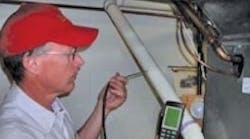By GREG GOATER
A technician checks the resistance value of a hot surface igniter (HIS).
Technician conducts a CO test in the flue of a condensing 90+ efficiency furnace.
Many times, clients have asked me if it's really necessary to have their gas furnaces cleaned every year.
After all, gas furnaces burn pretty cleanly, and there really isn't a need for "cleaning" every year. That's why we at Isaac Heating and Air Conditioning Inc. don't call our annual maintenance a furnace "cleaning." Certainly we clean the furnace, but, more importantly, we provide a precision tune-up and safety inspection (PTSI) on an annual basis.
Many of our PTSI clients are also service agreement customers who pay an annual fee that covers the furnace service, and includes a parts and labor allowance on any repairs needed through the season. In this case, it's definitely in both the client's and our best interest to spot trouble before it happens, to save the client the inconvenience of a service call, and to save us the expense of that service call.
To accomplish this effectively, our technicians follow a thorough checklist to ascertain the condition of the equipment.
Heat Exchanger Integrity, CO Test
A big part of Isaac Heating and Air Conditioning's PTSI is ensuring the integrity of the heat exchanger. This is done with a visual inspection from both the top and the bottom. In addition, our technicians carry fiber optic bore scopes to see inside the narrow passes in today's heat exchangers. Blowers are pulled on all furnaces to gain access to the lower section of the heat exchanger and recuperative coils (if equipped).
As the cost of testing equipment has come down, two years ago we began requiring our techs to do a carbon monoxide (CO) test on all furnace related calls. The test follows a protocol that was developed in concert with our local gas utility.
Start at the ‘Stat
We start with the thermostat to ensure that the unit does at least run when we get there (you'd be surprised at the number of customers who will try to pass off a repair as part of a "furnace cleaning"), and that the thermostat itself is functioning. We also check the heat anticipator setting, if so equipped.
Next, we remove and clean the pilot and main burners, inspecting the heat exchanger from this area while the burners are out. Flame rods are cleaned, and hot surface igniters (HSI) are checked for resistance value. We will often change a marginal HSI based on this resistance reading to save ourselves and the client a service call later in the season.
On a furnace that's equipped with a draft hood, we remove the draft hood and heat exchanger baffles to clean and inspect the heat exchanger from the top. We disassemble single wall vent connectors for inspection/cleaning of both the vent connector and the chimney connection.
Blower motors are cleaned and lubricated (if not permanently lubricated motors). Blower wheels are inspected and cleaned if necessary. (Dirty blower wheels are cleaned, at an additional charge). For the few belt-driven blowers that are left in our area, we inspect belts and pulleys, checking for cracks, abrasions, alignment, and tension, followed by blower bearing lubrication.
Once the furnace is reassembled, we change the return air filter(s), check and adjust the gas pressure as necessary, and measure the temperature rise across the heat exchanger.
We check all of the gas piping in the immediate vicinity for leaks, using electronic detectors. Air shutter adjustments are made to those burners where required, making sure we have a blue flame sitting down on the burner, and that it lights off smoothly. We then disconnect the blower motor, and cycle the furnace, making sure that the high limit switch will in fact shut down the burner.
We have found many a "fan center" that was installed when adding air conditioning, that bypassed the high limit switch, so this is a very necessary test. We would not do this test on a tubular heat exchanger; however, any furnace with this type of heat exchanger is newer, and will have a factory-installed fan center.
Often overlooked is the need to clean out the condensate trap and drain line on condensing furnaces. Failure to do this will most assuredly result in a service call for water on the floor, or no heat due to the pressure switches not making. This is definitely a case of a little effort going a long way toward eliminating callbacks.
Service Agreement Advantage
One service technician will perform between four and six PTSIs on a typical day, depending on the complexity of the equipment.
The beautiful thing about having service agreements is that we can schedule the PTSI's when we are slow, and free up all of our technicians for "no heat" calls when the weather gets severe.
Extra Effort Can Save Lives
A comment we often hear from new clients is, "The last company we had didn't do this much to our furnace when we had them clean it. I never knew there was so much to it!" When life, safety, and the inconvenience of no heat in the dead of winter are a concern, this is really a minimum amount consequences could be.
| Thorough Training Required to Perform PTSIs Further, during the course of the technician's initial training, we ensure that the equipment the tech will encounter in these supervised visits is varied and representative of the equipment that is typical for our area. — Greg Goater |












